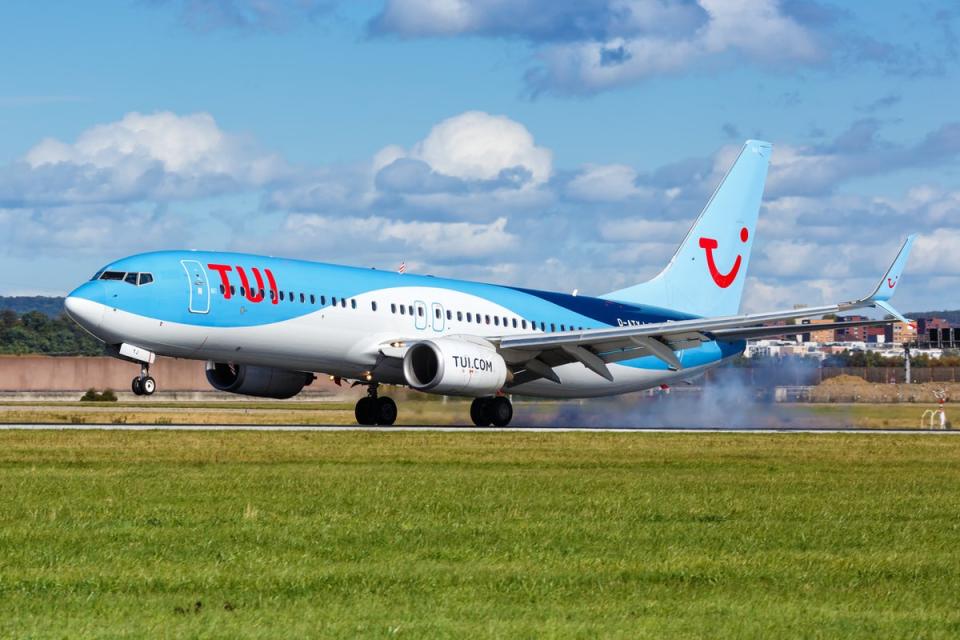Disaster narrowly avoided as plane clears Bristol Airport runway with just seconds to spare
A potential disaster was narrowly avoided when a packed passenger plane took off just seconds before it was about to run out of runway because of a software glitch.
The Boeing aircraft, operated by TUI, departed from Bristol Airport for Las Palmas, Gran Canaria on 9 March with 163 passengers on board when it struggled to take off.
The 737-800 plane cleared runway nine with just 260 metres (853ft) of tarmac to spare at a height of 10ft.
It then flew over the nearby A38 road at a height of just 30 metres (100ft) travelling at the speed of around 150kts (about 173mph).
The A38 is a major A-class busy road, connecting South West England with the Midlands and the north.
The Air Accidents Investigation Branch (AAIB), part of the Department for Transport, said the incident was the result of insufficient thrust being used during take-off.
Pilots manually set the thrust level following a software glitch that Beoing was aware of before take-off.

“A Boeing 737-800 completed a takeoff from Runway 09 at Bristol Airport with insufficient thrust to meet regulated performance,” the AAIB report said.
“The autothrottle (A/T) disengaged when the takeoff mode was selected, at the start of the takeoff roll, and subsequently the thrust manually set by the crew (84.5% N1 ) was less than the required takeoff thrust (92.8% N1 ).
“Neither pilot then noticed that the thrust was set incorrectly, and it was not picked up through the standard operating procedures (SOPs).”
The plane’s acceleration was significantly slower than 99.7 per cent of other aircraft of the same model departing the same airport, performance data collated by the AAIB showed.
The autothrottle system on a Boeing 737-800 can control the thrust from takeoff to landing, the AAIB added.
Boeing told investigators looking into the incident that they were aware of a “long history of nuisance disconnects during takeoff mode engagements”.
It added that plane was fitted with and FDR recording device, known as a ‘black box’, which records flight data and a CVR, which records the recent sounds in the cockpit.
The AAIB said: “G-FDZS was fitted with both an FDR and a CVR. The CVR fitted to G-FDZS was not removed from the aircraft as it continually overwrites itself, retaining only the last two hours of audio.
“As such, the recording of the takeoff would have been overwritten during the flight to Las Palmas. However, the FDR was removed and downloaded”.
The incident is the latest in a string of problems with Boeing jets in recent years.
The aerospace giant’s safety standards are coming under increasing scrutiny following several recent incidents, including one where a disused door fell off a brand new 737 Max shortly after take-off. There were no injuries.
In April a FedEx Airlines Boeing cargo plane landed at Istanbul Airport without the front landing gear deployed but managed to stay on the runway.
Five years ago, Boeing agreed to pay $2.5bn and make safety improvements after two new 737 Max jets crashed within the space of five months - one in Indonesia in 2018 and one in Ethiopia in 2019, killing a total of 346 people.
In May US officials warned Boeing it could face criminal charges after claims the airline failed to improve plane safety and adhere to a settlement after the deadly 737 crashes.
A TUI UK&I spokesperson said: “We have worked closely with the authorities to provide all available information.
“The AAIB recommendations and learnings resulting from this take-off will support the whole aviation sector and other airlines. The safety of our passengers and crew is always our highest priority.”
Boeing was contacted for comment.


